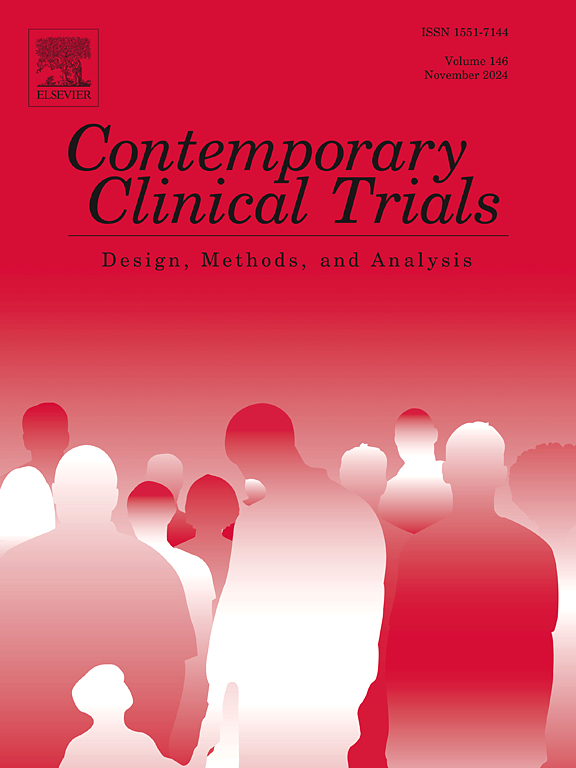蓝光与红光改善中风后睡眠、疲劳和认知的平行组随机对照试验:试验结果和进一步研究的建议。
IF 2
3区 医学
Q3 MEDICINE, RESEARCH & EXPERIMENTAL
引用次数: 0
摘要
背景:睡眠障碍和疲劳是中风急性期的常见症状,会阻碍患者的康复:睡眠障碍和疲劳是中风急性期的常见症状,会阻碍患者的康复:一项随机平行分组安慰剂对照试验研究比较了每天早晨照射蓝光或红光(安慰剂)对改善急性中风住院康复患者白天嗜睡、疲劳、夜间睡眠和认知能力的作用。方法:根据住院康复时间的长短,43 名因首次中风(缺血性 34 人,出血性 9 人;年龄 66.2 ± 14.1 岁)而继发睡眠障碍的患者被随机分配接受 5 天或更长时间的 25 分钟蓝光或红光照射(蓝光 21 人,红光 22 人)。在基线和出院时,使用卡罗林斯卡嗜睡量表和维茨图形嗜睡量表测量白天嗜睡程度,使用视觉模拟量表测量疲劳程度,使用雷伊听觉言语学习测试和追踪测试(TMT)测量认知功能。腕动仪测量夜间睡眠参数。研究结果表明,蓝光照射能显著改善睡眠质量:结果:暴露于蓝光可明显改善白天嗜睡、疲劳、听觉言语学习和睡眠开始时间(均为 p):急性中风后持续 5 天或更长时间的晨间蓝光照射比红光照射有更大的改善作用。效应大小表明,有必要进行更大规模的研究,以确认试验结果的普遍性:试验注册:ClinicalTrials.govNCT03125967(注册日期:2017年1月1日)。本文章由计算机程序翻译,如有差异,请以英文原文为准。
A parallel-group randomized controlled trial of blue light versus red light for improving sleep, fatigue, and cognition following stroke: Pilot results and recommendations for further study
Background
Disordered sleep and fatigue are common in the acute phase of stroke and can impede recovery.
Objective
A randomized parallel group placebo-controlled pilot study compared daily morning exposure to blue light or red light (placebo) for improving daytime sleepiness, fatigue, nocturnal sleep, and cognition in patients receiving inpatient rehabilitation for acute stroke.
Methods
43 patients with disordered sleep secondary to first episode stroke (n = 34 ischemic, n = 9 hemorrhagic; aged 66.2 ± 14.1 years) were randomized to receive 25 min of blue or red light for 5 or more days depending on inpatient rehabilitation length of stay (blue-light n = 21, red-light n = 22). At baseline and study discharge, daytime sleepiness was measured with the Karolinska Sleepiness Scale and Wits Pictorial Sleepiness Scale, fatigue with a visual analogue scale, and cognitive function with the Rey Auditory Verbal Learning Test and Trail Making Test (TMT). Wrist actigraphs measured nocturnal sleep parameters. Effect sizes were used to estimate sample sizes for larger studies.
Results
Blue light exposure led to significant improvements in daytime sleepiness, fatigue, auditory verbal learning, and time to sleep onset (all p < .05) relative to red light exposure (effect size range 0.75 to 1.83). Change in TMT, minutes of nocturnal sleep, and number of awakenings after sleep onset were not statistically significant (effect sizes range 0.38 to 0.57).
Conclusion
Morning blue light exposure for 5 or more days after acute stroke led to greater improvements than red light exposure. Effect sizes suggest a larger study is warranted to confirm generalizability of pilot findings.
Trial Registration: ClinicalTrials.gov NCT03125967 (Registered 01/01/2017).
求助全文
通过发布文献求助,成功后即可免费获取论文全文。
去求助
来源期刊
CiteScore
3.70
自引率
4.50%
发文量
281
审稿时长
44 days
期刊介绍:
Contemporary Clinical Trials is an international peer reviewed journal that publishes manuscripts pertaining to all aspects of clinical trials, including, but not limited to, design, conduct, analysis, regulation and ethics. Manuscripts submitted should appeal to a readership drawn from disciplines including medicine, biostatistics, epidemiology, computer science, management science, behavioural science, pharmaceutical science, and bioethics. Full-length papers and short communications not exceeding 1,500 words, as well as systemic reviews of clinical trials and methodologies will be published. Perspectives/commentaries on current issues and the impact of clinical trials on the practice of medicine and health policy are also welcome.

 求助内容:
求助内容: 应助结果提醒方式:
应助结果提醒方式:


